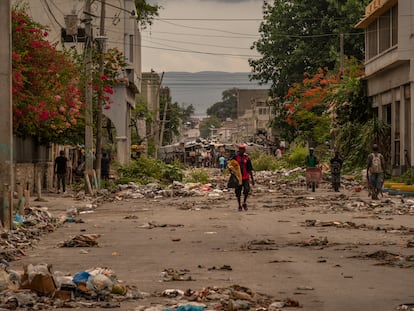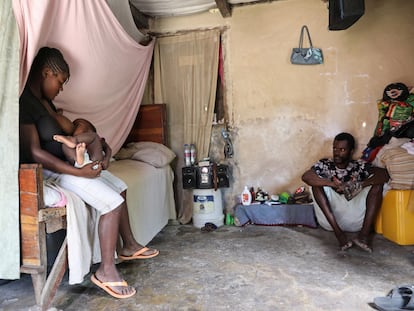Reborn from the rubble of Haiti
Two years after the earthquake that left more than 2,000 dead and destroyed the south of the Caribbean country, green shoots of hope are beginning to grow, but there is still a lot of work to do
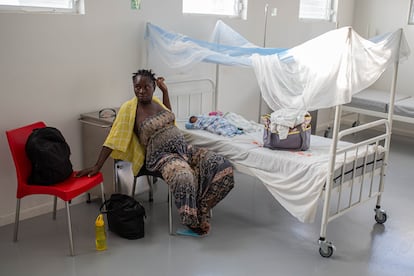
Two years have passed since the 7.2 magnitude earthquake that shook southern Haiti on August 14, 2021, causing more than 2,000 deaths and 12,000 injuries. The devastation was enormous and, as a result, many communities are to this day trying to recover and return to normality. Tens of thousands of buildings were destroyed and many health facilities, including the maternal care clinic in the city of Port-à-Piment, which was supported by Doctors Without Borders, were left unusable. The structure was damaged beyond repair, so the NGO decided to completely rebuild the building, thus improving the facilities and services that had existed before.
The new hospital was officially opened in February of this year, returning access to much-needed maternal care to the 250,000 people who make up this community. However, many of the medical facilities that were damaged in the earthquake have not been properly repaired and a large number of them remain closed. Therefore, access to medical care in general and mother-and-child care in particular remains very limited in the region.
Although the violence ravaging Haiti’s capital, Port-au-Prince, is far from the quiet coastal city of Port-à-Piment — about 150 kilometers (93 miles) to the southwest — its effects are being felt. Cuts in the supply chain have caused constant shortages of medicines and medical supplies in hospitals and clinics, and the blockade of the main fuel terminal in the port of Port-au-Prince by an armed gang last year also caused a serious fuel shortage in this region — a problem that remains far from being solved in a context in which the entire capital is controlled by these groups today.

In addition, many doctors from rural regions, including those from the Sud region, have left for Port-au-Prince, while many other doctors from Port-au-Prince have left the country fleeing the violence altogether. The 2021 earthquake only aggravated a situation that was already difficult before, due to poverty, years of political instability, the cholera epidemics that the country has suffered in recent years, and the consequences of previous natural disasters. Several organizations have promised financial and material aid to rehabilitate damaged medical structures, but these efforts are taking time to materialize, and the reality is that very few buildings have been repaired or rebuilt, and even fewer services have been restored.
All of these factors have left the health system in this part of the country in an extremely precarious situation, with a lack of medical supplies, personnel and adequate facilities. And this, logically, has a serious impact on the health of the community, especially that of pregnant women and newborns, as well as the elderly and other vulnerable groups.
Haiti has the highest maternal mortality rate in the Western Hemisphere, with 529 deaths per 100,000 births. Neonatal mortality is also very high, with 2,400 deaths per 100,000 babies born alive. One of the main reasons is that almost two out of three women (64%) do not give birth in healthcare facilities, which can have fatal consequences for both mother and baby if complications arise. That is why it is essential that births occur with the support of health professionals, since a quick response and having the appropriate means can mean the difference between life and death for both mother and baby.
The new Port-à-Piment maternity hospital, which we manage jointly with the Ministry of Health, now has an operating room for obstetric surgery, where doctors can perform cesarean sections, and a neonatal department, equipped with an intensive care unit. Our team also provides comprehensive sexual and reproductive health services, including contraceptive distribution and prenatal and postnatal consultations, and supports six health centers in towns and villages around Port-à-Piment. They also collaborate with networks of traditional midwives and community volunteers, allowing us to overcome the first obstacle to achieving better outcomes in everything related to maternal health: raising awareness among pregnant women and their families about when they should seek medical help.
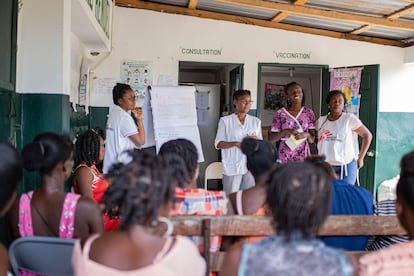
A few days ago, I visited the village of Rendel, which is located a dozen kilometers north of Port-à-Piment. To get there, you have to follow the bed of a dry river that crosses the mountains. The landscape is majestic. Our team, made up of medical personnel and health promoters, goes there once a week. “Rendel is one of the six places we support with education and health promotion,” one of our promoters, Guerline Georges, told me. “We talk to pregnant women about the main causes of death related to childbirth, such as preeclampsia or hypertensive disorder, and how to detect symptoms to anticipate complications and seek treatment quickly.”
I was able to see with my own eyes another of the main obstacles that the women of Rendel face: how difficult it can be to access a health center when they urgently need medical attention. The Sud region is sparsely populated, and it is very common for the nearest health center to be more than a dozen kilometers away, as was the case there. In addition, the roads are often in poor condition and transportation is expensive. In the particular case of Rendel, the dry river bed that we use as a path to get there fills with water in the rainy season, so it can take many hours for women who want to go to Port-à-Piment to walk to the health center there. Unfortunately, my colleagues explained to me, several women in labor have died in recent years while walking to a health center from towns like this one, succumbing to birth complications before reaching the medical center.
To solve these problems as much as possible, our teams are setting up reference committees in different towns, which help us facilitate the transportation of women in labor when they need it. And we also manage an ambulance service with all-terrain vehicles.
In Rendel I met Alexis Leone, a woman who was lucky enough to give birth safely despite the difficulties. “Four years ago, when I was pregnant with my first child, the doctors told me that I should go to the hospital if I felt any pain,” she told me. “Suddenly one day I started to feel bad, so I took the river path and walked to Port-à-Piment for a consultation. My blood pressure was too high, so MSF doctors took me by ambulance to a hospital an hour away, where I gave birth. Back then, there were not the means in Port-à-Piment that there are now. And if I had stayed in Rendel, they told me I probably would have died.”
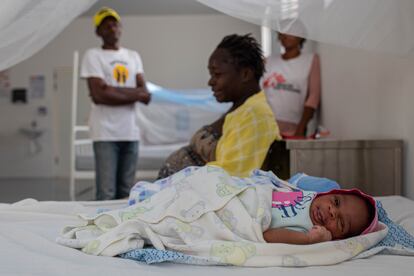
The referral from the previous MSF structure in Port-à-Piment to another hospital saved Alexis’s life, but my colleagues had already realized before the earthquake that organizing these referrals had become increasingly difficult, as the health centers in the region that patients were being referred to had difficulties providing vital services, due to lack of supplies, staff, and other problems. This is one of the reasons why, when we decided to rebuild the maternity hospital, we also decided to improve the services we had in Port-à-Piment. Thanks to that, patients who were previously referred to other centers to receive higher level care can now be treated right here at this center, which now offers cesarean sections, blood transfusions, and other care. Everyone you meet here tells you what a huge improvement it is for the inhabitants of Port-à-Piment and its surroundings.
The high number of patients that the center has treated demonstrates the enormous needs of the women of the Sud region. In 2022, before opening the new services and with the maternity hospital still half-rebuilt, our teams attended 700 births. And this year, from January to the end of June, the new hospital has attended 527 births, 60 of which were cesarean sections. And in this same period, a total of 159 babies were admitted to the hospital, 99 of them in the intensive care unit.
However, there are other cities and towns in the Sud region — such as Coteaux and Roche-à-Bateau — in which the health facilities that were destroyed have not been rebuilt. In Coteaux, for example, health personnel try to work in a training center, because the health center remains in ruins.
If we really want to reduce the high maternal and neonatal mortality rates in this region, much more needs to be done. It is essential that every pregnant woman be able to give birth with a trained healthcare professional, in the appropriate building, and with the necessary supplies. And to do this, other organizations must increase their help, starting with fulfilling the promises they made after the 2021 earthquake. More funds also need to arrive to help the Government pay the salaries of health workers in remote areas. It is the only way that to retain staff and incentivize others to come and work here. And it is the only way to reduce the mortality rates of pregnant women in this area of Haiti.
Sign up for our weekly newsletter to get more English-language news coverage from EL PAÍS USA Edition
Tu suscripción se está usando en otro dispositivo
¿Quieres añadir otro usuario a tu suscripción?
Si continúas leyendo en este dispositivo, no se podrá leer en el otro.
FlechaTu suscripción se está usando en otro dispositivo y solo puedes acceder a EL PAÍS desde un dispositivo a la vez.
Si quieres compartir tu cuenta, cambia tu suscripción a la modalidad Premium, así podrás añadir otro usuario. Cada uno accederá con su propia cuenta de email, lo que os permitirá personalizar vuestra experiencia en EL PAÍS.
¿Tienes una suscripción de empresa? Accede aquí para contratar más cuentas.
En el caso de no saber quién está usando tu cuenta, te recomendamos cambiar tu contraseña aquí.
Si decides continuar compartiendo tu cuenta, este mensaje se mostrará en tu dispositivo y en el de la otra persona que está usando tu cuenta de forma indefinida, afectando a tu experiencia de lectura. Puedes consultar aquí los términos y condiciones de la suscripción digital.
More information
Archived In
Últimas noticias
Most viewed
- Sinaloa Cartel war is taking its toll on Los Chapitos
- Oona Chaplin: ‘I told James Cameron that I was living in a treehouse and starting a permaculture project with a friend’
- Reinhard Genzel, Nobel laureate in physics: ‘One-minute videos will never give you the truth’
- Why the price of coffee has skyrocketed: from Brazilian plantations to specialty coffee houses
- Silver prices are going crazy: This is what’s fueling the rally
